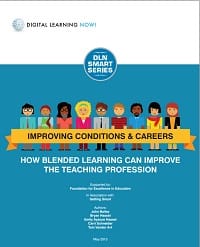 Taking a page from Public Impact’s "Opportunity Culture” playbook, this paper from Digital Learning Now! (the seventh in its “Smart Series”) argues that blended learning will help improve teacher satisfaction and reinvigorate the profession. Both are surely good things when one considers current teacher-satisfaction rates—which have dropped substantially over the past few years. The DLN/Public Impact team argues that blended learning allows for improved working conditions (with more opportunities for collaboration), more tailored professional development, more varied career advancement, and professional flexibility (including the ability to teach remotely). To be sure, the authors do not make a convincing case for heightened teacher satisfaction through all of their suggestions, such as why teachers would intrinsically support increased class sizes (in order to make the technology affordable). However, most recommendations make good educational sense. Profiles of schools (mostly charters) that have utilized blended learning to increase teacher effectiveness and streamline teacher workload speckle the text, reminding us that blended learning is about leveraging technology, not replacing teachers.
Taking a page from Public Impact’s "Opportunity Culture” playbook, this paper from Digital Learning Now! (the seventh in its “Smart Series”) argues that blended learning will help improve teacher satisfaction and reinvigorate the profession. Both are surely good things when one considers current teacher-satisfaction rates—which have dropped substantially over the past few years. The DLN/Public Impact team argues that blended learning allows for improved working conditions (with more opportunities for collaboration), more tailored professional development, more varied career advancement, and professional flexibility (including the ability to teach remotely). To be sure, the authors do not make a convincing case for heightened teacher satisfaction through all of their suggestions, such as why teachers would intrinsically support increased class sizes (in order to make the technology affordable). However, most recommendations make good educational sense. Profiles of schools (mostly charters) that have utilized blended learning to increase teacher effectiveness and streamline teacher workload speckle the text, reminding us that blended learning is about leveraging technology, not replacing teachers.
SOURCE: John Bailey, Bryan Hassel, Emily Ayscue Hassel, Carri Schneider, and Tom Vander Ark, How Blended Learning Can Improve The Teaching Profession (Tallahassee, FL: Foundation for Excellence in Education, May 2013).
